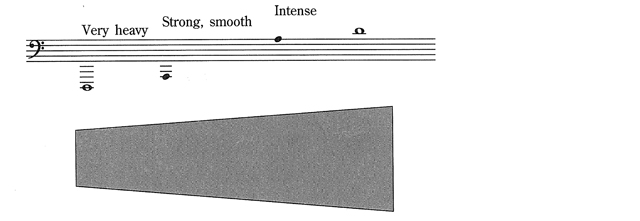Tuba, Euphonium and Baritone
IT: tuba – FR: tuba – GER: Basstuba
Properties
The tuba has a large, conical bore and either three or four valves of rotary or piston design. The fourth valve is used to adjust intonation with other valve combinations. Tubas are also available with five or six valves. The most common shape is with upright bell, but some student models are bell front, and marching bands may use the helicon design. All have deep cup mouthpieces. The power and weight of the instrument can be fully appreciated when experienced in a live performance, and is difficult to convey with a digital sample.
Range and Natural Dynamics


FIGURE 4.10 Tuba range
Transposition
Tubas are nontransposing; they sound as written. Bass clef and ledger lines are always used (not 8va). The compass is ordinarily from DD upwards approximately three octaves. The most common tubas are the double C and double B♭ (also called contrabass tuba). The tuba in F is smaller and a bit brighter.
Tone Quality
The tuba’s sound is rich and expressive throughout its range. Lower pitches lack focus, and higher pitches sound strained. A velvety piano and powerful forte are available at most pitch levels.
Technical Abilities
The tuba is very agile, notwithstanding its size, and can articulate rapidly. Wide leaps and rapid passage work are possible, but slow, sustained writing is more characteristic. Because a great deal of breath is required, ample rests should be employed. Blending well with all the instruments, it is often combined in unison with double bass or bassoon.
Musical Example


FIGURE 4.11 Tuba line: Richard Strauss, Also Sprach Zarathustra, nine measures after rehearsal number 50, two tubas in octaves with trombones
A memorable excerpt featuring the tuba can be found in Wagner’s Die Meistersinger nine measures after letter J.
Euphonium and Baritone
The euphonium and baritone are basically the same instrument. A smaller member of the tuba family, the euphonium is often made with a slightly larger bore than the baritone. It employs four valves, compared to three on the baritone. More agile and flexible than the tuba or trombone, the euphonium is a standard member of the band, not the orchestra.
Baritone horn players are frequently former cornet or trumpet players because the fingering patterns are the same, and for this reason band parts are occasionally written in the treble clef a major ninth higher for the baritone. The standard notation is in bass clef, sounding as written, and the range is the same as that of the tenor trombone. Pedal tones are available on each valve position in the lowest register.
